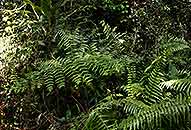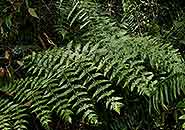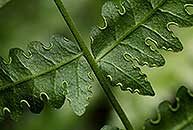Blotiella natalensis (Hook.) R.M. Tryon
Synonyms |
Lonchitis natalensis Hook. |
|---|---|
Common name |
|
Description |
Rhizome erect, massive and woody, forms a caudex up to 20 cm in diameter. Fronds tufted or closely spaced, arching, up to 3 m long. Stipe up to 1 m, straw-coloured, sparsely set with short scales. Lamina up to 2 m long, lanceolate-ovate, narrowly oblong or triangular in outline, pinnate to 2-pinnate (to 3-pinnatifid) and hairy on both surfaces. Pinnae increasingly deeply incised from the apex to the base with shallowly lobed pinnules. Terminal pinna ± hastate, pinnatifid and terminal segments of lateral pinnae similar with ± 7 pairs of lobes; pinnae narrowly oblong to narrowly triangular in outline, (7.5–)18–31 x(1.5–)3–12 cm, stalked, deeply pinnatifid with lobes lanceolate-triangular in outline, up to ± 4 x 1 cm, narrowly joined at bases; in 2-pinnate fronds the pinnae have a deeply crenate terminal segment gradually passing into distinct pinnules which are narrowly triangular or lanceolate in outline, 4.5–7.5 x 1.5–2.2 cm, sessile, entire to wavy crenulate or pinnatifid; surfaces sparsely to densely set with adpressed hairs, the costa with short hairs even if surface glabrescent; rhachis hairy, becoming glabrous below. Sori circular to crescent-shaped, situated at the base of the sinuses between the pinnules, but in more dissected fronds also in shallow sinuses of lobed margins of pinnules or pinna-lobes, up to ± 10 per pinnule and in places sometimes appearing almost continuous; indusium present. |
Notes | Differs from B. glabra by having an erect, stem-like rhizome and fronds that are up to 3 m long. Tectaria gemmifera has laminal sori and buds or plantlets on the rhachis or costae. |
Derivation | natalensis: of Natal, South Africa from where W.J. Hooker first described this fern in 1851. |
Habitat | Near shaded streambanks or in seepage zones in evergreen forest, streamside woodland, secondary vegetation in regenerating forest cleared two to three years previously. |
Distribution worldwide | Widespread in Africa, also Madagascar, Comoro Isl., Seychelles and Mauritius. |
Distribution in Africa |
Angola, Burundi, Dem. Republic of Congo, Guinea, Ivory Coast, Kenya, Malawi, Mozambique, South Africa, Tanzania , Uganda, Zambia, Zimbabwe. |
Growth form |
Terrestrial. |
Literature |
|


